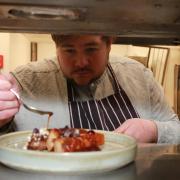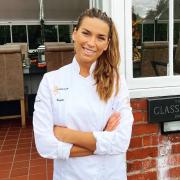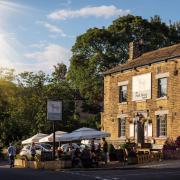We’ve all heard of Bakewell Pudding, but some famous Derbyshire foodie creations are less known. Oliver explores the origins of local delicacies, including Tharf Cakes, and Chesterfield Soup.
Ashbourne Ginger

The story goes that during the Napoleonic wars, a French prisoner of war was billeted in Ashbourne, where he gave the family he was staying with the recipe for gingerbread. It consists of soft, soda-raised wheat flour, and is made with egg, treacle (or golden syrup) and ginger.
The Gingerbread Shop was built in 1492 and is believed to be the very building where the French soldier shared the recipe.
It has been a bakery since 1805 and has been in the same family for four generations - each a baker by trade, just like the last.
Ashbourne Ginger has been made in this very bakery for well over a century. Today it produces and sells the town’s traditional delicacy, alongside sandwiches and hot food items to tourists and travellers who pass through.
Tharf Cakes
While its origin is a bit murky – people historically enjoyed tharf cakes in Cumberland (now Cumbria) as well as Sheffield and even as far as Scotland – there is a good case for it having been invented in the Derbyshire Dales.
Made with oatmeal, treacle, ginger and (depending on the recipe) taking the form of a cake or biscuit, Tharf Cakes are most associated with Bonfire Night, where people across the country now make for the occasion.
One of the earliest references to the recipe was in a 1934 edition of this very magazine, in which someone known as ‘Derbyshire W.I. Member’ mentioned it as a local recipe, made in Bakewell and Wirksworth. Celebrated Peak District author Crichton Porteous noted in 1976 that it was ‘still made in Matlock.’
Sometimes called ‘Thor’ cakes, the director of local bakery chain, Stacey’s Bakery, dressed up as the Marvel Norse superhero for a publicity campaign in 2016. Since then, they have sold over 17,000 cakes.
Melandra Loaf
Dating back to 1974, and invented by the Derbyshire Federation of Women’s Institutes, this is a wonderful fruit bread that can still be tasted at The Old Bakery in Youlgrave.
It’s purported to have a connection to the Roman Fort at Glossop, named ‘Melandra’, but this is in dispute as the ingredients for the loaf would not have been available during Roman times.
It was made more famous by the funky TV chef duo The Hairy Bikers after an appearance on their 2021 BBC Two show, The Hairy Bikers Go North, with their version studded with ‘pineapple, cherries, currants and dates.’
According to them, it’s the ‘ideal travelling companion’ and ‘toasts really well.’ The popular pair spoke of Derbyshire’s long baking tradition, with Dave calling it ‘unbelievable.’
Hartington Stilton Cheese

A little southwest of Bakewell lies the village of Hartington - famous for its beautiful creamy Stilton cheese.
Robert Gosling, director of Hartington Creamy, tells me the creamery only uses milk from the Derbyshire Dales, and is all handmade by in-house artisan producers.
Hartington Creamery has an interesting history. Set up in the 1870s by the Duke of Devonshire, Thomas Nuttall began creating Stilton at the turn of the century, which became famous throughout the world - they even held a warrant to produce for King George V!
It was so special, in fact, that production was legally confined to Leicestershire, Nottinghamshire and, of course, Derbyshire.
In August 2023, Hartington Creamery legally acquired the production rights to Sage Derby cheese – bringing it back to Derbyshire, rather than Warwickshire where it had been made for hundreds of years.
Bakewell Pudding

Not to be confused with the Bakewell Tart (as many Derbyshire folk will tell you), the Bakewell Pudding is a delicious dessert with a fluffy pastry base, a layer of strawberry jam and topped with a spongy layer of eggs, sugar and almonds.
Supposedly invented at some point in the 19th century – there are references to the recipe in multiple cookbooks between 1820 and 1860 – local legend has it that it was a mistake by a chef at the White Horse Inn, who had been following instructions left by the landlady Mrs Greaves.
Stephen Craig, general manager at the Old Original Bakewell Pudding Shop (there are three shops in the village that claim the original recipe), says it was ‘subsequently sold to Annie Wilson’ who began producing and selling Bakewell Puddings around 1860.
Chesterfield Soup
Chesterfield Soup’s connection to Derbyshire is tenuous at best, but it could offer the reclaiming of a great recipe for the region.
The only solid evidence is the recipe’s inclusion in Good Things in England, a collection of recipes dating back to the 14th century, which was published in 1932 by Florence White.
The book was reprinted multiple times, even as late as 1999, and her work continues to have a lasting impact on England’s culinary heritage.
While she has no personal connection to Derbyshire, she was interested in the food produced by the region.
White became increasingly focused on making a ‘gastronomic map of England.’ It stands to reason that if the Chesterfield Soup did exist, she would know about it.
And it seems she did, as she writes in her 1932 book that a Chesterfield Soup is a ‘calf's tail soup with vegetables and sherry or madeira’, as well as added mushrooms.
While nobody, it seems, is making this today - why don’t you give it a try?
Derbyshire Oatcakes
A variation of a Scottish biscuit, the Derbyshire Oatcake is a cross between a pancake and a crumpet.
Since 1949, the best have arguably been made at Owlgreave Farm at a village in the Peak District, Combs.
It’s traditionally made with oatmeal, as with Derbyshire's climate and poorer soils, it’s much easier to grow oats than wheat.
Buxton Water

The most recognisable food and drink export from Derbyshire is undoubtedly Buxton Water – purely because of the commercial awareness of the company (Nestle) that owns the brand: BUXTON Water.
Buxton has a rich and storied history, with the local waters thought to have had healing qualities in the Victorian era, much like places such as Harrogate or Scarborough.
While Nestle has authority from the local council to bottle and sell the water, residents and visitors have perpetual rights to bottle their own water from St Anne’s spring – and many do.
Gill Williamson, a member of the Buxton Civic Association, sees the food and drinks heritage as ‘an interesting bit of town identity, in some cases reflecting contemporary or earlier agriculture in the surrounding area.’
She adds that she ‘certainly has local cheese, beers, oatcakes and Buxton Pudding in stock when I have visitors staying with me!’
Melton Mowbray Pies

An honourable mention, Melton Mowbray pies are, clearly, from Leicestershire, but are commonly enjoyed alongside all of Derbyshire’s famous cheeses – the industries are also closely linked, with many manufacturers sharing ingredients.
The self-professed ‘Rural Capital of Food’, Melton Mowbray will be recognised by many as the name on the pork pies you may get from the supermarket. They’re a pork filling, covered in gorgeous pastry, traditionally made with a bow on top.
Clare O’Donnell, experience manager at Brocklebys, tells me the secret to making the perfect pie is ‘excellent free range pork, a goodly quantity of white pepper and a crisp crust - the pie
ideally being “hand raised”.’
They offer pie making classes at their site on Melton Road, with bread and sausage making classes soon to come.



























